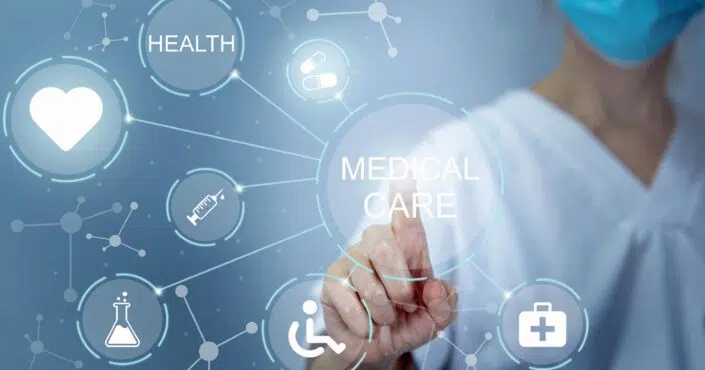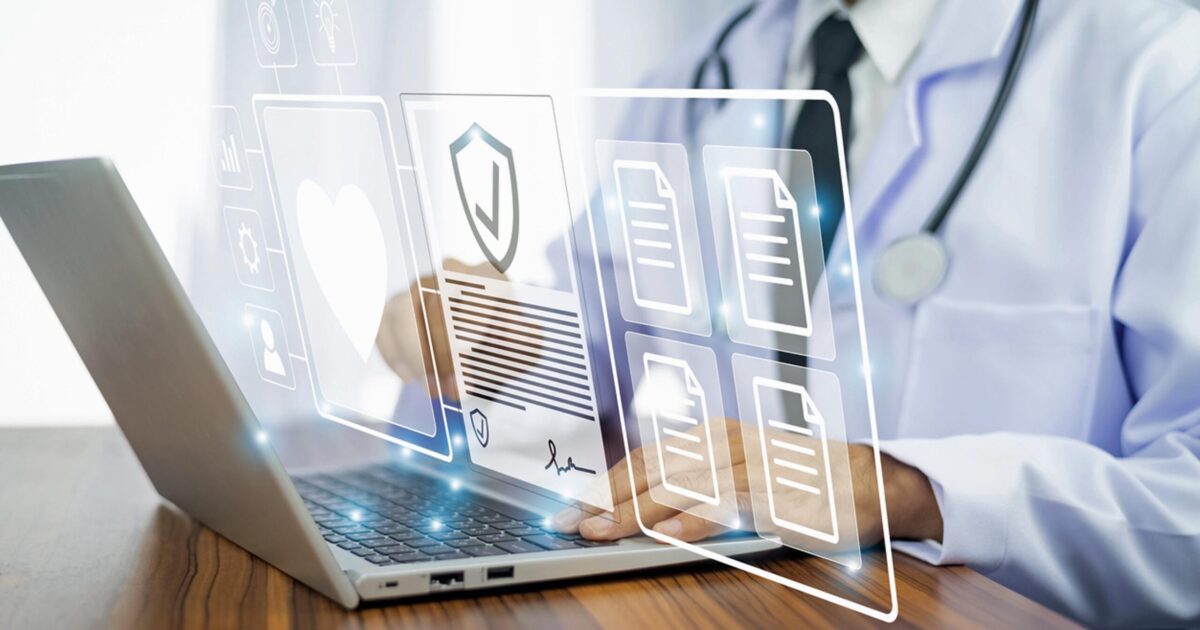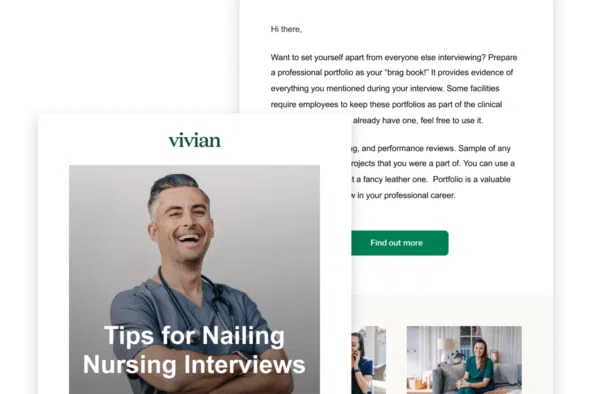The pandemic prompted significant changes for healthcare professionals, such as streamlining processes, increasing virtual appointments and discarding traditional paper documents in favor of more convenient and sanitary digital recordkeeping. However, embracing innovation isn’t new – science and medicine consistently evolve to improve methodologies. Today, technology takes center stage in the latest healthcare trends.
Nurses and healthcare professionals prioritize evidence-based practice, making it essential to stay current. The good news is that adopting and mastering these trends will streamline your nurse or allied health professional job. At Vivian Health, we want to help you stay updated with the latest trends in healthcare throughout your career. Join us as we explore five pivotal trends shaping the healthcare landscape heading into 2024.
1. Revolutionizing Patient Care through Technology
Digital health innovations, including wearable health monitors and mobile health apps, have significantly transformed patient care in recent years. These technologies leverage the power of digital advancements to enhance monitoring, communication and overall healthcare delivery.
Wearable Health Monitors
A prominent trend in healthcare has been the increasing capability of patients to self-monitor their health using wearable devices such as Fitbit, Garmin and smartwatches. The evolution has gone from simple step counting to monitoring heart rate and sleep patterns, as well as insights into stress levels and continuous glucose monitors (CGMs).
CGMs allow people with diabetes to continuously monitor blood sugar levels, reducing the need for frequent fingerstick tests and offering more personalized treatment plans. This constant stream of data enables better health management. A tangible look at a patient’s health allows individuals to proactively approach their health and wellness.
Many institutions now use electronic health records (EHR) and are beginning to integrate device data into patient portals. New companies intend to develop technology for enhanced wearable health monitors and EHR integration, allowing a seamless transition of patient data to healthcare providers. The data collected by these tools enables healthcare providers to tailor treatment plans to individual patient needs, improving overall outcomes and more efficient healthcare delivery, reducing the burden on healthcare systems and potentially lowering overall costs.
Mobile Health Apps
Many mobile health apps help patients stay on track with their health. Apps like Medisafe and MyTherapy help patients adhere to their medication schedules. The apps send reminders, track doses and provide educational content to improve compliance, leading to better health outcomes.
With growing mental health awareness, apps like Headspace, Calm and Talkspace offer resources for stress reduction, mindfulness and even virtual counseling sessions. These tools increase accessibility and contribute to holistic patient care by addressing mental and emotional well-being.
2. Bridging the Gap Through Telehealth and Remote Care
The growth of telehealth services is skyrocketing, reshaping patient access and healthcare delivery. The telehealth revolution is also transforming the way healthcare providers connect with patients. Imagine being equipped with connected health devices like blood pressure monitors, scales and pulse oximeters, creating a seamless stream of real-time patient data. As a telehealth nurse, you can monitor patients with chronic conditions from afar, stepping in when needed to prevent hospital readmissions.
The rise of telehealth apps such as Doctor on Demand, Teladoc and Amwell empowers nurses to extend care beyond the hospital walls. Implementing virtual nursing enables the examination of more patients in a shorter period, potentially offering a solution to the widespread post-pandemic nursing shortage across the nation. Patients can now consult with healthcare providers remotely, making non-emergency cases, follow-ups and routine check-ups a breeze, enhancing both convenience and accessibility.
While there are many pros to the rise in telehealth and remote care accessibility, it also comes with challenges. Some challenges healthcare providers and patients may have include:
- Technical Barriers
- Digital Literacy
- Limited Access to Technology
- Reimbursement Policies
- Legal Complexities
- Data Security and Privacy Concerns
- Patient Confidentiality
- Integration with Existing Systems
- Resistance to Change
- Building Trust
- Scope and Limitations of Telehealth
3. Exploring Artificial Intelligence in Healthcare Trends
Bringing technology and artificial intelligence (AI) into healthcare can address challenges like high costs and supply-and-demand imbalances in our healthcare system. AI has the potential to reshape healthcare by improving diagnostics, treatment planning and patient management.
In diagnostics, it quickly analyzes medical images like X-rays and MRIs, potentially enhancing accuracy. AI customizes treatment approaches using individual patient data for more effective and personalized care. In patient management, AI facilitates proactive healthcare through remote monitoring and predictive analytics, identifying potential issues early for timely interventions.
AI is designed to enhance and work alongside human intelligence, not replace it. When developing AI systems for healthcare, it’s essential to refine and improve vital aspects of human interaction in medicine rather than eliminating them. This approach aims to enhance efficiency and effectiveness. The progress of AI in healthcare relies on a deep, human-centered understanding of the complexities in patient journeys and care pathways.
AI evolves by leveraging the data it receives to construct an algorithm, continually enhancing its ability to provide more accurate answers. Ethical considerations regarding the inclusion of patient data in such a system raise concerns. Navigating and respecting ethical boundaries during the transition to incorporating AI in healthcare is crucial for ensuring the responsible and secure use of patient information.
RELATED: Personalized Healthcare: How this Trend Impacts HCPs and Patients
4. Safeguarding Patient Information in a Digital Age
With so much information kept digitally, recognizing the growing importance of data security and privacy in healthcare has become increasingly important to ensure every patient’s personal data is kept safe. According to the Identity Theft Resource Center (ITRC) 2022 Data Breach Report, U.S. healthcare organizations remain the most frequently affected by data breaches for the third consecutive year, reporting 344 breaches in 2022. Healthcare organizations are at the greatest risk for the following attacks:
- Phishing: Attackers use deceptive emails, messages or websites to impersonate trustworthy entities in this type of cyber attack.
- Ransomware: This type of malicious software encrypts a healthcare organization’s files or systems, rendering them inaccessible. Attackers then demand a ransom payment, usually in cryptocurrency, in exchange for providing the decryption key.
- Insider Threats: Sensitive digital information compromised from within the organization is the foundation of insider threats.
- Distributed Denial-of-Services (DDoS) Attacks: Attackers overwhelm a system, network or website with excessive traffic volume, rendering it temporarily or completely unavailable in a DDoS attack.
- Advanced Persistent Threats (APTs): Sophisticated and prolonged cyber attacks where adversaries gain unauthorized access to a network or system to steal sensitive information or cause persistent harm results in APTs.
- Malware: This type of malicious software compromises, damages or gains unauthorized access to computer systems, networks or devices.
- Internet of Things (IoT) Attacks: IoT attacks stem from malicious targeting of connected medical devices and systems. As healthcare increasingly relies on IoT technologies for patient monitoring, diagnostics and other critical functions, attackers may exploit vulnerabilities in these interconnected devices.
In numerous cyber attacks, crucial information is frequently rendered inaccessible, potentially resulting in life-or-death situations for patients. This high level of attack on digital information within healthcare proves the continued need for the utmost attention to cyber security.
To do this, it’s necessary for organizations to not only comply with existing regulations but also proactively adopt measures to ensure the secure handling and privacy of patient data, bolstering trust in the digital healthcare landscape. A vital role of healthcare providers and organizations is to maintain the following best practices:
- Prevent data breaches
- Mitigate risks with appropriate software
- Protect data privacy
- Ensure compliance with regulations
- Health Insurance Portability and Accountability Act (HIPAA)
- Health Information Technology for Economic and Clinical Health (HITECH) Act
- Adopt security safeguards
- National Institute of Standards and Technology (NIST) Framework for Improving Critical Infrastructure
- Center for Internet Security (CIS) Critical Security Controls
5. Rising Trend of Micro-Hospitals
The emergence of micro-hospitals constitutes a noteworthy development in healthcare, introducing a model that seamlessly integrates inpatient and outpatient services. A micro-hospital is a compact healthcare facility providing a range of medical services in a smaller, localized setting. Typically two to three-story buildings, these facilities operate 24/7 with services like emergency care, labs, inpatient care, imaging and pharmacies. They aim to fill healthcare service gaps in areas with limited demand for traditional hospitals. Micro-hospitals offer a middle ground between urgent care and larger hospital facilities, providing comprehensive services in a more community-focused setting.
Esteemed players in this arena, such as Emerus Holdings and SCL Health, spearhead this transformative approach. SCL Health, headquartered in Denver, Colorado, has established four micro-hospitals in diverse neighborhood settings. These healthcare facilities are also emerging in other states, including Colorado, Nevada, Texas and Arizona. Nursing jobs in micro-hospitals require versatility in skills and the ability to adapt and be flexible due to limited resources.
The impact extends beyond the clinical realm, shaping a more personalized patient care experience. As the prevalence of micro-hospitals rises, understanding their role in healthcare delivery is imperative for healthcare professionals, aligning practices with patient-centered care.
A Transformative Era in Healthcare
The convergence of healthcare trends like digital health innovations, telehealth expansion, increased use of artificial intelligence, a heightened focus on patient data security and the rise of micro-hospitals has ushered in a transformative era in healthcare. This convergence has reshaped the roles and responsibilities of healthcare professionals, including nurses and allied health professionals, and necessitated their swift adaptation to evolving circumstances.
In this dynamic landscape, adaptability is paramount. Healthcare professionals must prioritize ongoing education and skill development to stay abreast of emerging technologies and changing practices, ensuring they deliver optimal care in an ever-evolving healthcare environment.
Take the next step in your career by exploring the exciting nursing opportunities in telehealth on Vivian Health. Don’t miss out on these valuable openings that could shape your professional journey.









